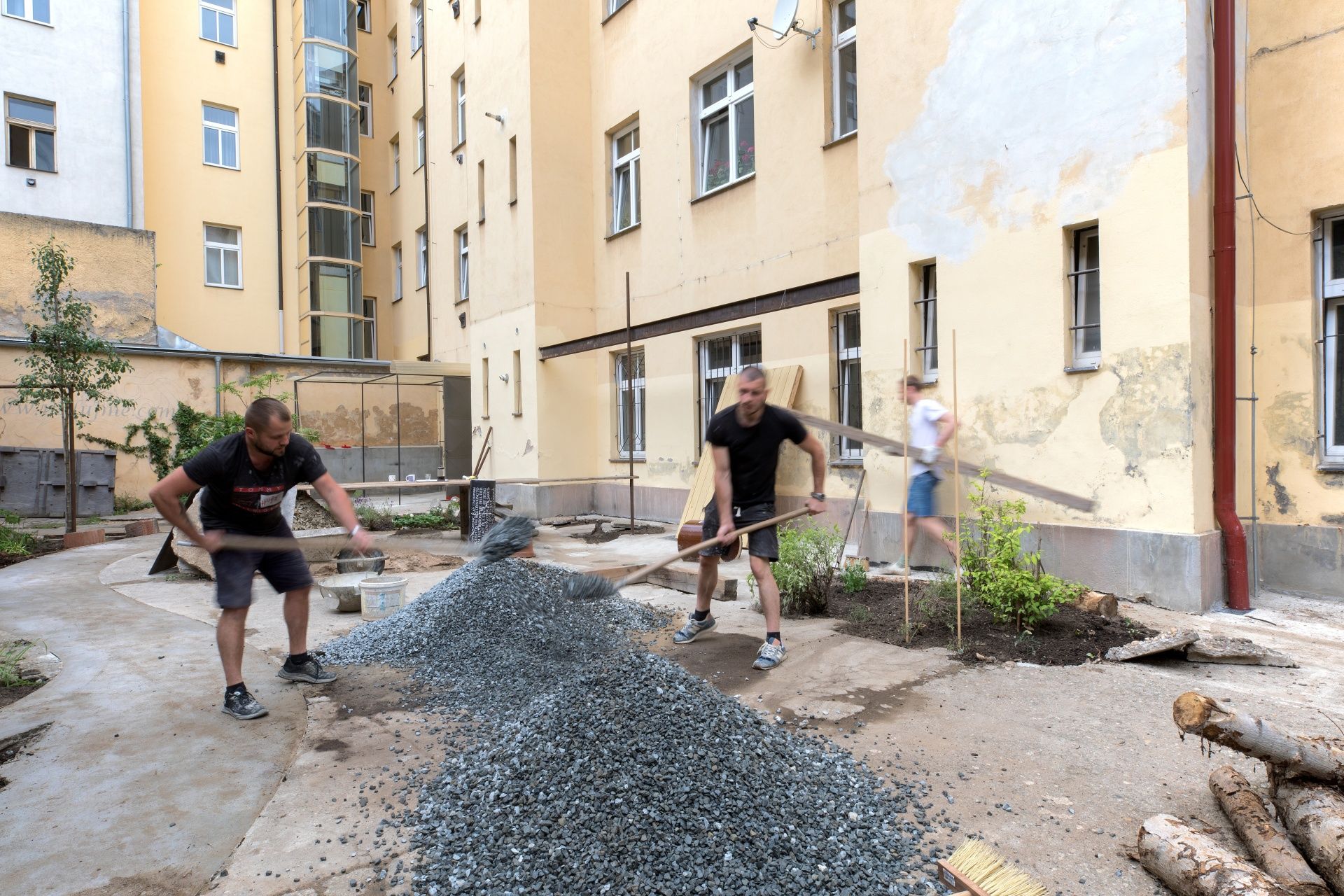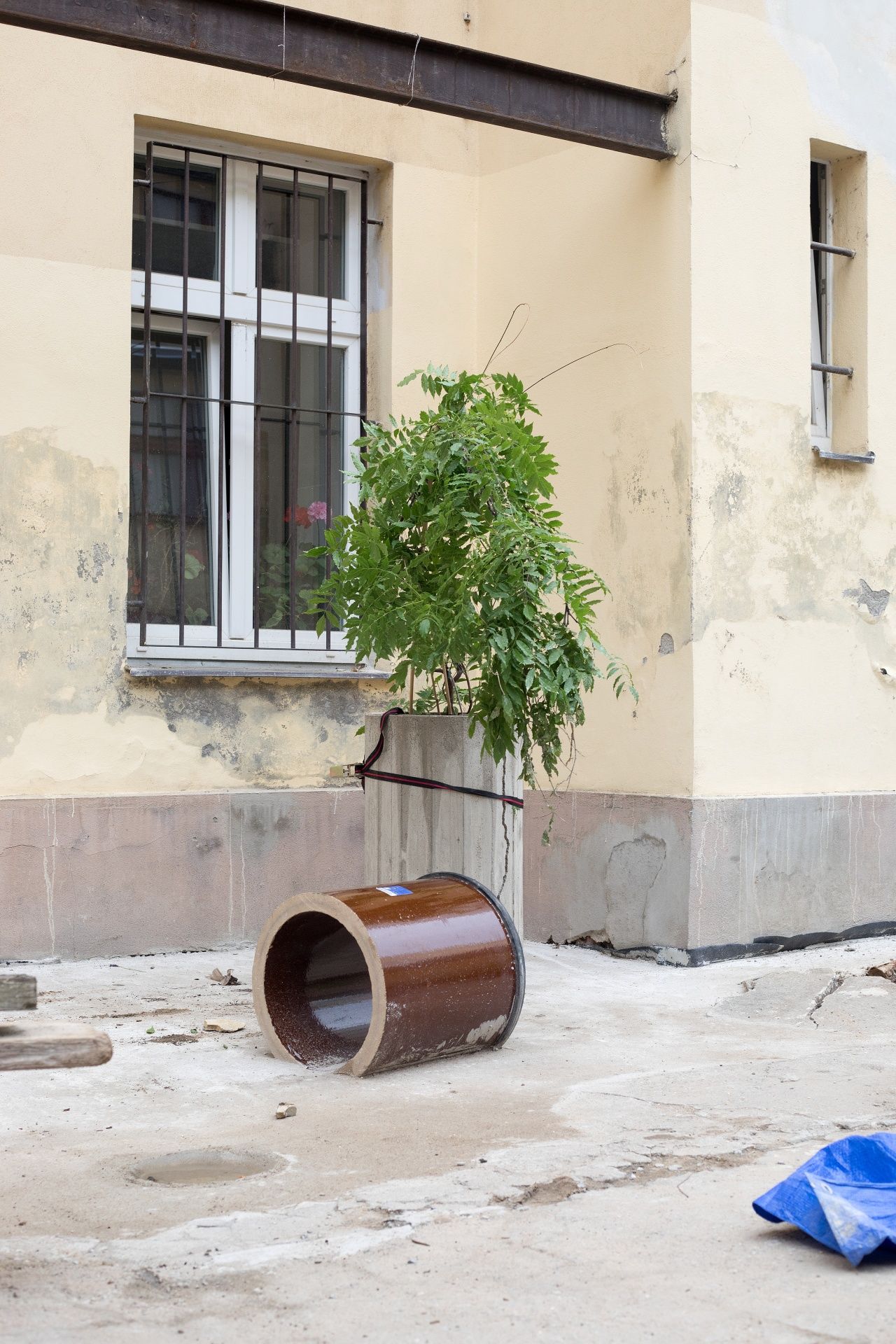DOMINIK LANG: Pojďme ven, i když prší! / Let’s go outside, even if it rains!
4 May – 24 June 2023
Doprovodný text k výstavě v ČJ, Staveniště – Edith Jeřábková
“We often think of architecture as something that is given, has some unwritten rules and expectations. I promise myself that this space won’t be like that, but will be as open and welcoming as possible, without moments that define us into some positions, determine a hierarchy or an order.” (D. Lang)
Construction site
Cultural worker: What are you doing here?
Dominik Lang. I am working on a construction site.
Cultural Worker: But the exhibition should already be finished, ready for tomorrow’s opening!
Dominik Lang: It seemed a bit stagnant to me; nothing was happening.
Cultural worker: What do you mean there was nothing going on, after all it deals with pressing issues of the day.
Dominik Lang: Sure, but it seemed so polished and finished that it didn’t make sense in the context of the pressing issues of the day. I wanted to open the exhibition up to those issues again.
Cultural worker: Well, when will the exhibition close? What are we going to tell people? What are we going to say to the visitors who come to the gallery and are going to be disappointed not to see a finished exhibition?
Dominik Lang: We’ll tell them how it is, what is going on and take them through the exhibition.
Cultural Worker: Well, but what are we going to talk about on this site? About how this work will be finished in a week or two?
Dominik Lang: We will talk about the burning issues of today and we perceive them now from this place. The site is like a garden or a playground, it is constantly being transformed not only by the will of the gardener, but by the needs of all the diverse creatures who live and work here. I’ll sketch out a scenario.
Cultural Worker: Someone should write a clear and explanatory text for that, so that the viewer can understand what is going on.
Edith Jeřábková: Dominik Lang lives and works on a construction site and in the garden. You are now in the place of his frequent presence. If he’s not here, he’s most likely at school. If there are a group of people here, it’s probably children or students and Dominik is most likely to be among them; it’s hard to miss him, as he likes, ruefully, to say – no ego attached. He generally is wearing workmen-like clothing, which always reminds me that a comparison between the work of an artist* and that of a manual worker* could, if analysed closely, reveal a lot of interesting things not only about the working practices of contemporary art, but more importantly about the conditions of work in general, and artworks in particular. By making his artworks work, Lang shows work as art and art as work. Dominik Lang has a radar for still waters. He likes quiet, wise and calm ones for their constant slow changes and processes and others he has the urge to stir up so that their surroundings do not dry up. He’s not hastily obsessed with moving forward, but now and then he likes to break a dam or build another one with beavers in places where the water spills beautifully into the landscape for the frogs to hop around. For some, such as developers or eager new homeowners, a building site is an unwanted but necessary stage on the way to the destination, and its existence should be limited to the shortest possible time, and even shorter, and covered by formwork. Against this conception of the building site as restlessness and disorder, Dominik contrasts the conception of the building site as infinite calm and order. For Dominik, the construction site is a Zen garden in which things happen just by moving a stone or rolling a ball. It’s a garden that the gardener doesn’t want to leave; on the contrary, he wants to invite everyone into it who is interested in seeing things on the surface of the water. What’s more, Dominik has a radar for places where change is about to happen. Some people rescuing animals (which Dominik also does) and someone rescue places. He’s a place activist. He harnesses energies so that good, or as it is more often called these days, ethical change happens. Or he opens up places themselves to processes to make them happier. But Dominik is no Zen master, he lives the life of an activist who is supposed to be in ten places at one time, and even though it seems impossible, he somehow manages.
This place: I become part of the gallery, I have changed identity, I am an imperfect transformation. I am exchanging organs with the gallery next to me; parts of my body are moving into it and parts of it are moving out into me. It’s a strange feeling. I am suddenly being intensely observed, not as a patient, but more like a larva turning into a butterfly, if I may indulge in that cliché. It’s both pleasant and unpleasant. I am an object, but I am also a gallery, I am not sure what I am. Will I have a name like exhibitions, galleries, artists, butterflies have? Or will I become a courtyard again, which I still am thanks to my still functional organs, old concrete, dirt and walls. The gallery next to me is frequented by people and even dogs; everyone who comes is invited to join me – to fly, to crawl, to climb, to reach, to seed, to plant, to branch.
Dominik Lang at the opening, which is an ending, or viceversa: I will come to finish this after the opening, so that it doesn’t look like an awkwardly limited exhibition project. An exhibition is an unbounded agency and the place has to be observed for a long time before the processes settle down.
Motto Karen Barad: Crucially, agency is a matter of intra-acting; it is an enactment, not something that someone or something has. Agency is doing/being in its intra-activity. It is the enactment of iterative changes to particular practices – iterative reconfigurings of topological manifolds of space-time-matter relations through the dynamics of intra-activity. Agency is about changing possibilities, of change entailed in reconfiguring material-discursive apparatuses of bodily production, including the boundary articulations and exclusions that are marked by those practices in the enactment of a causal structure. Particular possibilities for (intra-)acting exist at every moment, and these changing possibilities entail an ethical obligation to intra-act responsibly in the world’s becoming, to contest and rework what matters and what is excluded from mattering.
Anička: Daddy, tie your shoelaces and let’s run down the hill.
Text by Edith Jeřábková





 view from exhibition Let’s go outside, even if it rains!, hunt kastner, Prague, 2023, foto: Michal Czanderle
view from exhibition Let’s go outside, even if it rains!, hunt kastner, Prague, 2023, foto: Michal Czanderle 

 view from exhibition Let’s go outside, even if it rains!, hunt kastner, Prague, 2023, foto: Michal Czanderle
view from exhibition Let’s go outside, even if it rains!, hunt kastner, Prague, 2023, foto: Michal Czanderle 



 view from exhibition Let’s go outside, even if it rains!, hunt kastner, Prague, 2023, foto: Michal Czanderle
view from exhibition Let’s go outside, even if it rains!, hunt kastner, Prague, 2023, foto: Michal Czanderle